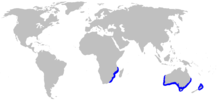| Thorntail stingray | |
|---|---|

| |
| Scientific classification | |
| Domain: | Eukaryota |
| Kingdom: | Animalia |
| Phylum: | Chordata |
| Class: | Chondrichthyes |
| Subclass: | Elasmobranchii |
| Superorder: | Batoidea |
| Order: | Myliobatiformes |
| Family: | Dasyatidae |
| Genus: | Dasyatis |
| Species: | D. thetidis
|
| Binomial name | |
| Dasyatis thetidis J. D. Ogilby, 1899
| |

| |
| Range of the thorntail stingray[2] | |
| Synonyms | |
|
Dasyatis lubricus Smith, 1957 | |
The thorntail stingray, black stingray, or longtail stingray (Dasyatis thetidis) is a species of stingray in the family Dasyatidae. It is found off southern Africa, Australia, and New Zealand from the intertidal zone to a depth of 440 m (1,440 ft). This bottom-dweller inhabits soft-bottomed habitats such as lagoons, estuaries, and reefs. Growing to 1.8 m (5.9 ft) across and over 200 kg (440 lb) in weight, the thorntail stingray is among the largest stingrays in the world. Uniformly dark above and light below, it has a diamond-shaped pectoral fin disc and a very long, whip-like tail with a fin fold underneath. The upper surface of the disc and the tail bear numerous stout, sharp thorns.
The diet of the thorntail stingray consists of benthic invertebrates and bony fishes. It has been known to gather in large groups during summertime. Like other stingrays, it is aplacental viviparous, with the developing embryos sustained to term by histotroph ("uterine milk") produced by the mother. The venomous stinging spine of the thorntail stingray can inflict a painful injury, though it is not aggressive towards humans. It is caught by commercial and recreational fishers, though the impact of such activities on its population is unknown. As a result, the International Union for Conservation of Nature (IUCN) has listed this species as Data Deficient in 2008.[3]
- ^ Jabado, R.W., Chartrain, E., De Bruyne, G., Derrick, D., Dia, M., Diop, M., Doherty, P., Finucci, B., Leurs, G.H.L., Metcalfe, K., Pires, J.D., Seidu, I., Soares, A.-L., Tamo, A., VanderWright, W.J. & Williams, A.B. (2021). "Bathytoshia lata". IUCN Red List of Threatened Species. 2021: e.T104071039A104072486. doi:10.2305/IUCN.UK.2021-2.RLTS.T104071039A104072486.en. Retrieved 10 July 2023.
{{cite journal}}: CS1 maint: multiple names: authors list (link) - ^ Last, P.R. & J.D. Stevens (2009). Sharks and Rays of Australia (second ed.). Harvard University Press. pp. 439–440. ISBN 978-0-674-03411-2.
- ^ Stevens, J.D. (2008). "Dasyatis thetidis". IUCN Red List of Threatened Species. 2008. Retrieved January 7, 2010.
